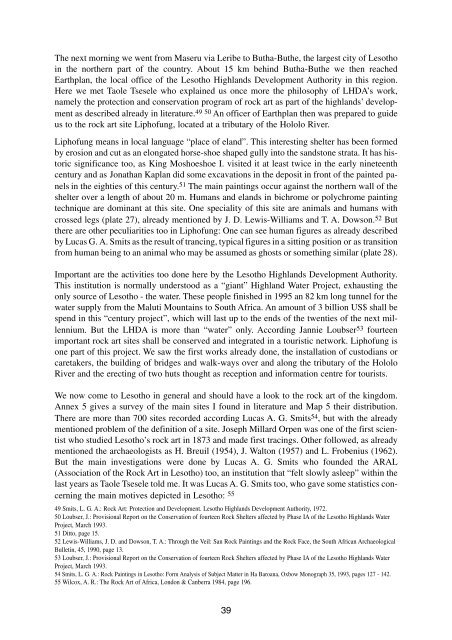1.) schw.weiss - StoneWatch
1.) schw.weiss - StoneWatch
1.) schw.weiss - StoneWatch
You also want an ePaper? Increase the reach of your titles
YUMPU automatically turns print PDFs into web optimized ePapers that Google loves.
The next morning we went from Maseru via Leribe to Butha-Buthe, the largest city of Lesotho<br />
in the northern part of the country. About 15 km behind Butha-Buthe we then reached<br />
Earthplan, the local office of the Lesotho Highlands Development Authority in this region.<br />
Here we met Taole Tsesele who explained us once more the philosophy of LHDA’s work,<br />
namely the protection and conservation program of rock art as part of the highlands’ development<br />
as described already in literature. 49 50 An officer of Earthplan then was prepared to guide<br />
us to the rock art site Liphofung, located at a tributary of the Hololo River.<br />
Liphofung means in local language “place of eland”. This interesting shelter has been formed<br />
by erosion and cut as an elongated horse-shoe shaped gully into the sandstone strata. It has historic<br />
significance too, as King Moshoeshoe I. visited it at least twice in the early nineteenth<br />
century and as Jonathan Kaplan did some excavations in the deposit in front of the painted panels<br />
in the eighties of this century. 51 The main paintings occur against the northern wall of the<br />
shelter over a length of about 20 m. Humans and elands in bichrome or polychrome painting<br />
technique are dominant at this site. One speciality of this site are animals and humans with<br />
crossed legs (plate 27), already mentioned by J. D. Lewis-Williams and T. A. Dowson. 52 But<br />
there are other peculiarities too in Liphofung: One can see human figures as already described<br />
by Lucas G. A. Smits as the result of trancing, typical figures in a sitting position or as transition<br />
from human being to an animal who may be assumed as ghosts or something similar (plate 28).<br />
Important are the activities too done here by the Lesotho Highlands Development Authority.<br />
This institution is normally understood as a “giant” Highland Water Project, exhausting the<br />
only source of Lesotho - the water. These people finished in 1995 an 82 km long tunnel for the<br />
water supply from the Maluti Mountains to South Africa. An amount of 3 billion US$ shall be<br />
spend in this “century project”, which will last up to the ends of the twenties of the next millennium.<br />
But the LHDA is more than “water” only. According Jannie Loubser 53 fourteen<br />
important rock art sites shall be conserved and integrated in a touristic network. Liphofung is<br />
one part of this project. We saw the first works already done, the installation of custodians or<br />
caretakers, the building of bridges and walk-ways over and along the tributary of the Hololo<br />
River and the erecting of two huts thought as reception and information centre for tourists.<br />
We now come to Lesotho in general and should have a look to the rock art of the kingdom.<br />
Annex 5 gives a survey of the main sites I found in literature and Map 5 their distribution.<br />
There are more than 700 sites recorded according Lucas A. G. Smits 54, but with the already<br />
mentioned problem of the definition of a site. Joseph Millard Orpen was one of the first scientist<br />
who studied Lesotho’s rock art in 1873 and made first tracings. Other followed, as already<br />
mentioned the archaeologists as H. Breuil (1954), J. Walton (1957) and L. Frobenius (1962).<br />
But the main investigations were done by Lucas A. G. Smits who founded the ARAL<br />
(Association of the Rock Art in Lesotho) too, an institution that “felt slowly asleep” within the<br />
last years as Taole Tsesele told me. It was Lucas A. G. Smits too, who gave some statistics concerning<br />
the main motives depicted in Lesotho: 55<br />
49 Smits, L. G. A.: Rock Art: Protection and Development. Lesotho Highlands Development Authority, 1972.<br />
50 Loubser, J.: Provisional Report on the Conservation of fourteen Rock Shelters affected by Phase IA of the Lesotho Highlands Water<br />
Project, March 1993.<br />
51 Ditto, page 15.<br />
52 Lewis-Williams, J. D. and Dowson, T. A.: Through the Veil: San Rock Paintings and the Rock Face, the South African Archaeological<br />
Bulletin, 45, 1990, page 13.<br />
53 Loubser, J.: Provisional Report on the Conservation of fourteen Rock Shelters affected by Phase IA of the Lesotho Highlands Water<br />
Project, March 1993.<br />
54 Smits, L. G. A.: Rock Paintings in Lesotho: Form Analysis of Subject Matter in Ha Baroana, Oxbow Monograph 35, 1993, pages 127 - 142.<br />
55 Wilcox, A. R.: The Rock Art of Africa, London & Canberra 1984, page 196.<br />
39
















